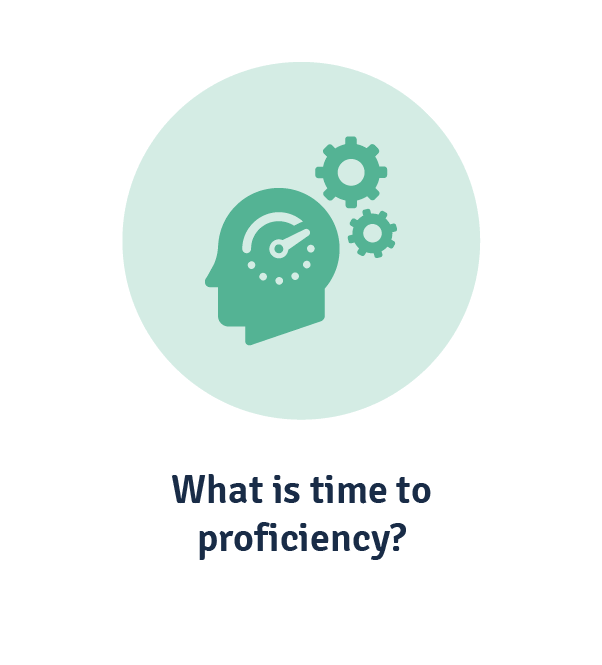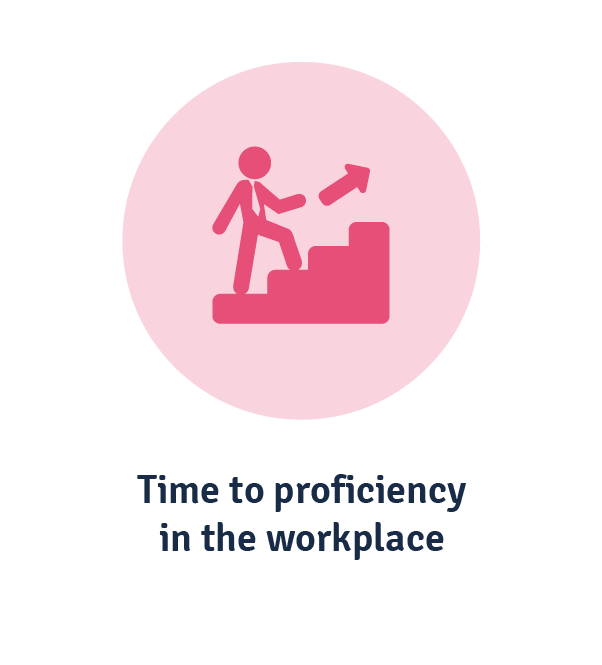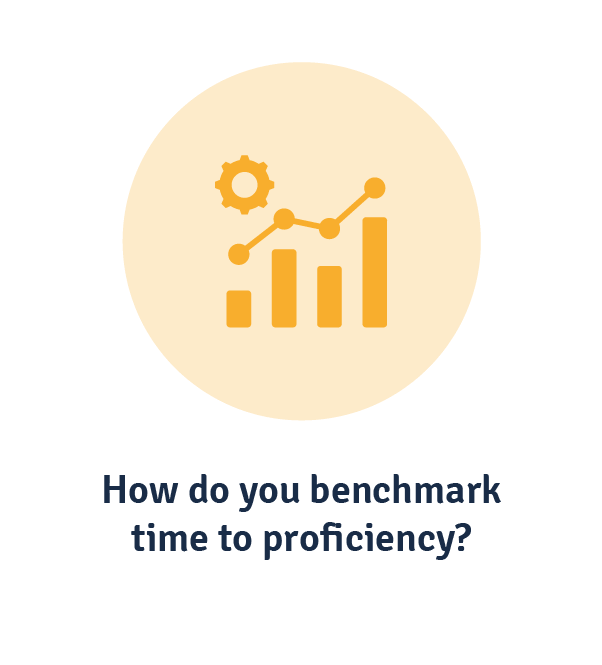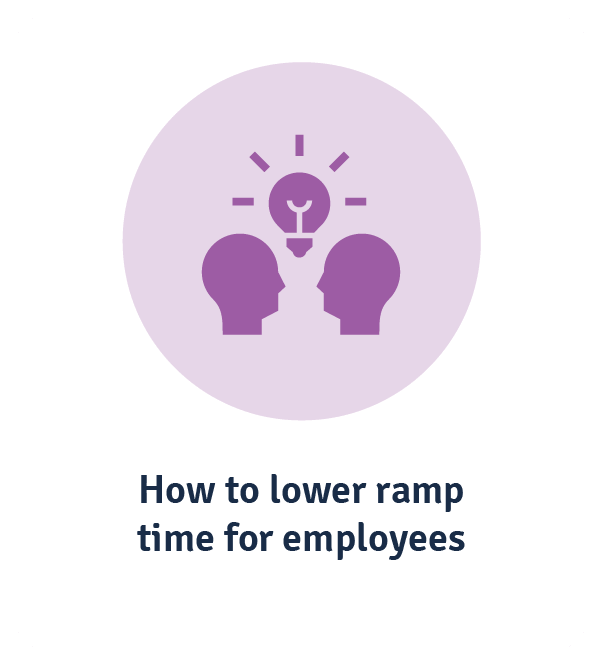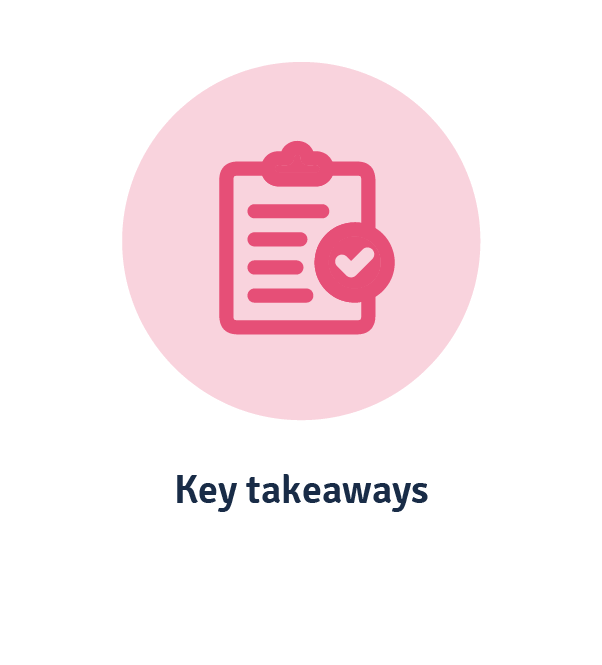Proficiency is a key measure of employee performance in the workplace. Time to proficiency is the way to understand how long it takes transitioning current or new employees to be impactful in a new role.
Slow time to proficiency has a number of reverberating impacts in today’s business environment: Lowered productivity, heightened attrition and a potentially significant financial impact on the organisation as a whole.
So, how do you measure time to proficiency and increase the ramp time of employees? We lay it out for you in this guide.
What is time to proficiency?
Time to proficiency is the time taken by an employee to develop the capabilities needed to perform at an acceptable level in a job role.
There are two instances in which you’d want to measure time to proficiency:
- A new starter begins at your organisation.
- When an employee assumes a new role.
You may also know it as ramp time. Whatever phrasing you prefer, measuring, nurturing and catching it is an important part of the work environment.
Why is time to proficiency important in the workplace?
It can take eight months for a new hire to reach full productivity. New leaders can still be underperforming 18 months after they assumed the role.
In terms of business, that’s (at least) the better part of a year of lost productivity. Add to that a 23% turnover rate of new hires in the first year (mostly from poor onboarding), and you’re looking at:
- Unstable team dynamics
- Consistently high recruitment costs
- Unfettered capability gaps
- Strained resources as employees retcon mistakes from new hires
- Decreased competitive advantage.
All in all, time to proficiency is a business challenge as much as a performance management issue.
Factors that affect time to proficiency
So, just why didn’t these new hires or leaders make the splash you were hoping for? In very few circumstances is a slow ramp time indicative of a new employee’s capabilities. Before you write it off as an issue of work ethic, consider a few systemic barriers that can result in a longer time to proficiency.
Decentralised knowledge
They say knowledge is power, and for good reason. Consider the sales process. That’ll be a complex beast within your organisation, with various documents, stakeholders, information, and deadlines for a new employee to understand. They’ll be customer facing, too, which makes mistakes less forgivable.
But if all the knowledge they need to do their job exists only in the minds of their coworkers, rather than in centralised documentation, it’s not likely that said new employee will follow a standardised process. It’ll also mean that learning the tricks of your trade becomes an exercise in talking to people, taking them away from their responsibilities, and ultimately eating into everyone’s productivity.
Capturing critical knowledge isn’t always easy with traditional knowledge or learning management systems. They just don’t have the functionality for it, which is why we pioneered the performance learning management system. The PLMS, as it’s otherwise known, is designed to codify and operationalise capabilities to improve organisational performance. That is, you can capture key interactions happening amongst your high performers, and turn them into shareable learning assets to promote knowledge transfer at scale.
Lack of role clarity
If an employee doesn’t clearly understand their job role and responsibilities, how can they be expected to behave and perform in the way you need them to? That can lead to:
- Overlapping responsibilities or replication of effort
- Unclear reporting lines
- Conflicting and changing expectations of performance and processes
- Poor prioritisation through lack of context.
New employees face double the challenge of acclimating to your culture while stepping into their responsibilities. If they accidentally toe someone else’s line, you risk destabilising the workplace culture with unnecessary competition.
Lack of support
Harvard Business Review research found that only 43% of organisations ensure employees transitioning into management receive onboarding, support and guidance. Yet, the same research showed the most productive, innovative and engaged employees establish solid connections from the start of their tenure in a role.
Consider remote workers. Not only do they miss out on the ability to quickly chat through questions with coworkers, but they lack understanding of the social cues exhibited in person. It may make it harder for them to raise issues, be included on projects or showcase capabilities, further extending their time to proficiency.
How do you benchmark time to proficiency?
If the aim is to accelerate proficiency, you need to clarify the guardrails for a proficient performance.
As a refresher, benchmarking is the process of measuring your business practices and metrics to compare them with other functions in your organisation or against competitors, in order to improve performance. We wouldn’t recommend the latter when creating stable measures of proficiency, because the best measure of proficiency should be unique to your organisation.
Yes, we’re talking about capabilities and their younger sibling, competency. One gives you the performance marker and the other a performance measure. Using a capability framework works because:
- It’s a stable, predictable and objective tool against which to assess employee performance.
- Gaps in competency or proficiency are easily ascertained with definitive metrics for ideal performance.
- The language used is universal, so managers and employees are on the same page.
- You can better pinpoint where slow time to proficiency is having a truly negative impact on business, providing more impactful training interventions.
How to lower ramp time for employees
The simple answer is good onboarding. What that actually looks like is a little more complex.
Training is generally your first line of defence when it comes to addressing time to proficiency. That isn’t just formal training programs, but support mechanisms that correct mistakes in real time and reinforces new skills and knowledge in the moment.
Ongoing training
For new hires, don’t just give them an office tour and a million reading materials and call it a day.
On-the-job learning offers a strong chance of post-training skills application, while online modules belonging to a centralised knowledge system allow employees to access information in the flow of work.
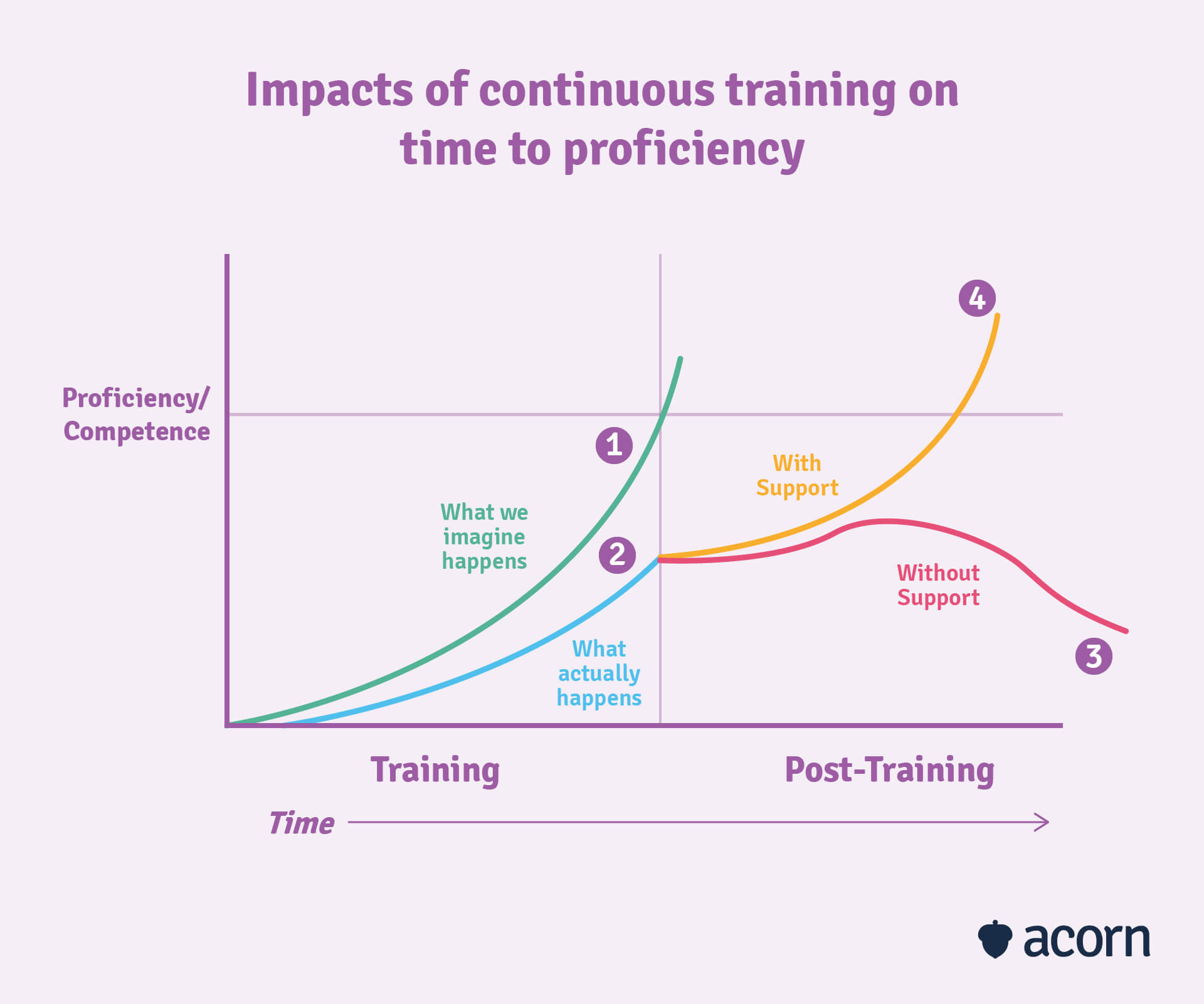
Essentially: Create and offer learning programs that address DIY issues. Consider how evergreen the introductory material you offer is, as it may take a while for certain processes or knowledge to really sink in. Think demo recordings for new sales reps or short courses for design software—content that addresses common questions and that they can freely return to in moments of need (intent to learn is a key factor in how likely learners are to remember new information).
Getting training content right for ramp
- Mix up formats. Utilise social learning to layer cultural ways of work into knowledge sharing.
- Map training to different points of the onboarding journey.
- Curate content around the scenarios certain job roles face.
Support & mentoring
One of the best ways to impart organisational knowledge is through mentors and role models. For new employees, this usually looks like a buddy who is their first point of contact.
It’s a little trickier for transitioning managers. The period to full job proficiency isn’t marred by lack of context, but new and challenging responsibilities. Mentoring new leaders should focus on giving them greater business perspective to reflect the level of reach they now have.
As a whole, mentoring new starters helps to correct detrimental behaviours through real-time feedback and a psychologically safe environment.
Getting mentoring right for ramp
- Put employees on real projects, so they can bounce ideas off experienced mentors.
- Schedule regular, dedicated check ins within the period you expect them to be fully proficient.
- Continue mentoring post-probation and training. It’ll help reinforce networks, culture and capabilities.
Key takeaways
Though traditionally seen as a tool for HR, L&D and people managers, time to proficiency is inherently related to the systems of support within the workplace.
Providing role clarity and a single source of truth through training and mentoring enables employees to learn new capabilities in the context of your organisation. This is key to shortening time to ramp, as it ensures that they are getting the right information, exactly when they need it.
And that’s the crux of the time to proficiency conundrum. It comes down to solid onboarding that allows wiggle room for mistakes to be made, but also corrected before they’re a business problem rather than just a performance issue.
Related Reads on This Topic

The Benefits of Mentoring Employees & Ways to Establish a Mentoring Program
Are you offering mentoring to your employees? Workplace mentoring programs help employees reach their full potential and this guide shows you how…

The How-To Guide to Effective Capability Assessment
Read more to discover how capability assessments measure the capabilities of both your business and individual employees…

Why Does Proficiency Matter to the Success of Your Business?
Proficiency is a key driver of business success. If your team and process are optimised, all that remains is highly proficient performance…
